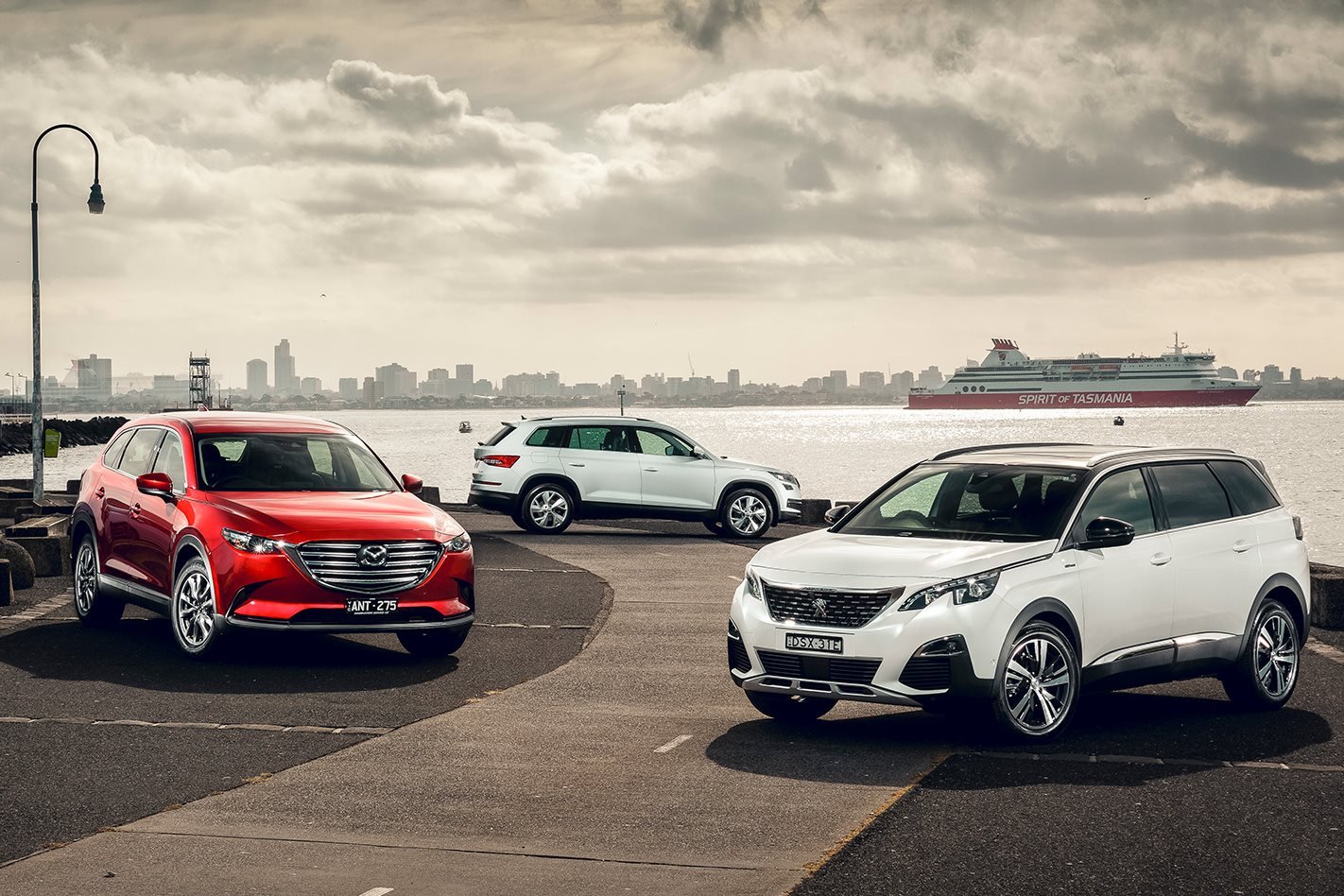IT’S UNHEARD of for a road test to be concluded before you’ve driven the cars, but I reckon this one could be a done deal. Peugeot’s 5008 has just pulled up to the bowser alongside the Mazda CX-9 and, to be honest, it looks like Grant Denyer squaring up to Lennox Lewis. Both have seven seats and both are priced around 50 grand, but the similarity ends there.
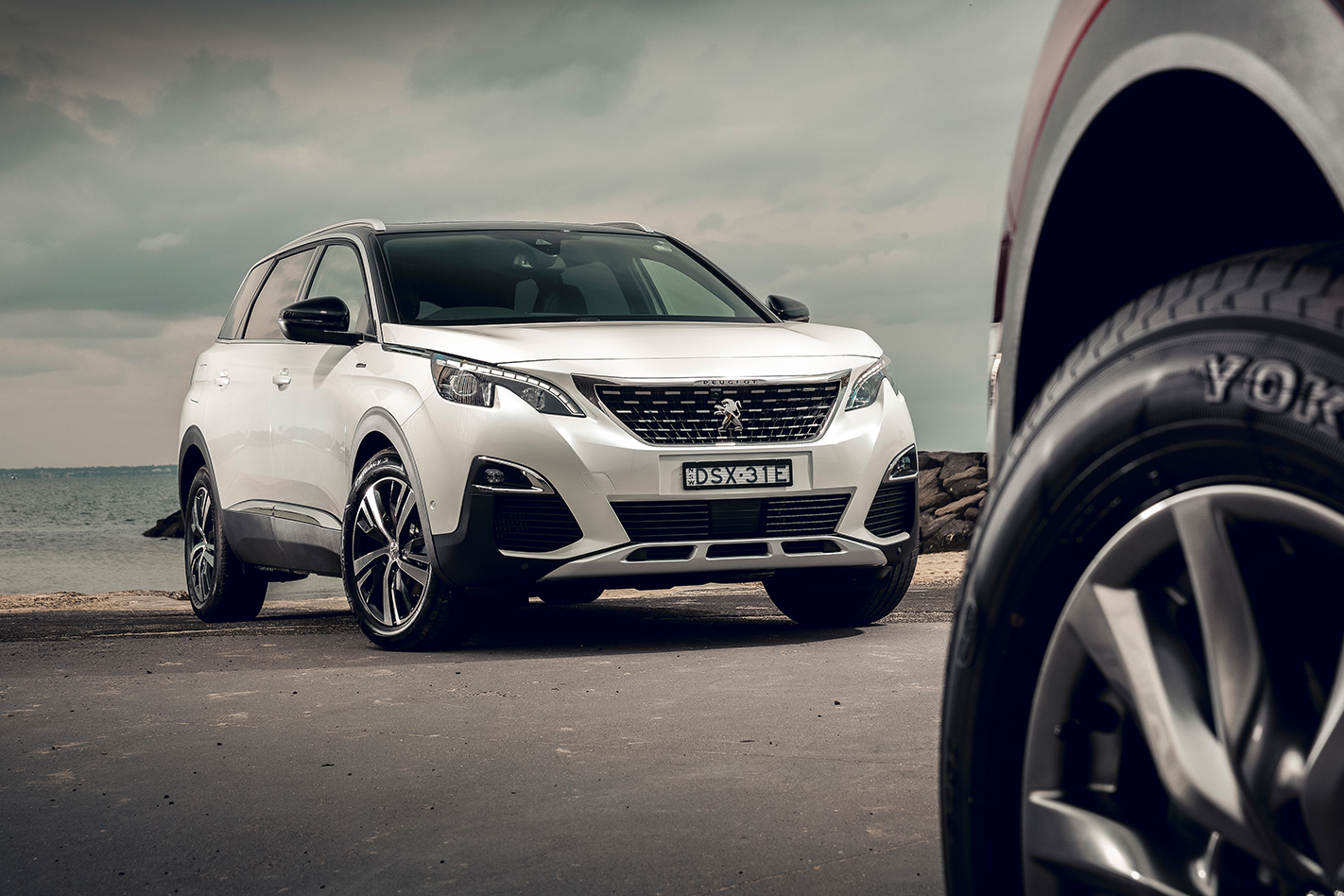
The large Japanese SUV dwarfs the svelte Peugeot, its roofline arcing way above that of the mid-sized 5008, its flanks and overhangs all solid heft against the Pug’s pinched surfacing. We know the CX-9 is a formidable package, so the category-busting Peugeot will need to bring something utterly exceptional to win this one.
Its task isn’t made any easier by the inclusion of the Skoda Kodiaq, an SUV that came within striking distance of this year’s Wheels Car of the Year crown, only to be pipped by the Volvo XC60. We rated the Skoda’s practicality, value and dynamics then, and we’re interested to see how it stacks up to both the 2017 champ and the new pretender from Rennes-la-Ja nais.
You’ll be forgiven if you feel a sense of deja vu about the 5008. The first generation was an amorphous MPV that shared its underpinnings with Citroen’s previous C4 Grand Picasso. Marginally better to drive than its gormless looks suggested, the 5008 was studiously ignored by Aussie buyers from 2013 before being quietly taken outside and shot. The badge has once again returned on a vehicle based on the new-gen Grand Picasso, but this time round it appropriates the styling cues of an SUV, despite lacking any semblance of propulsion to the rear axle.
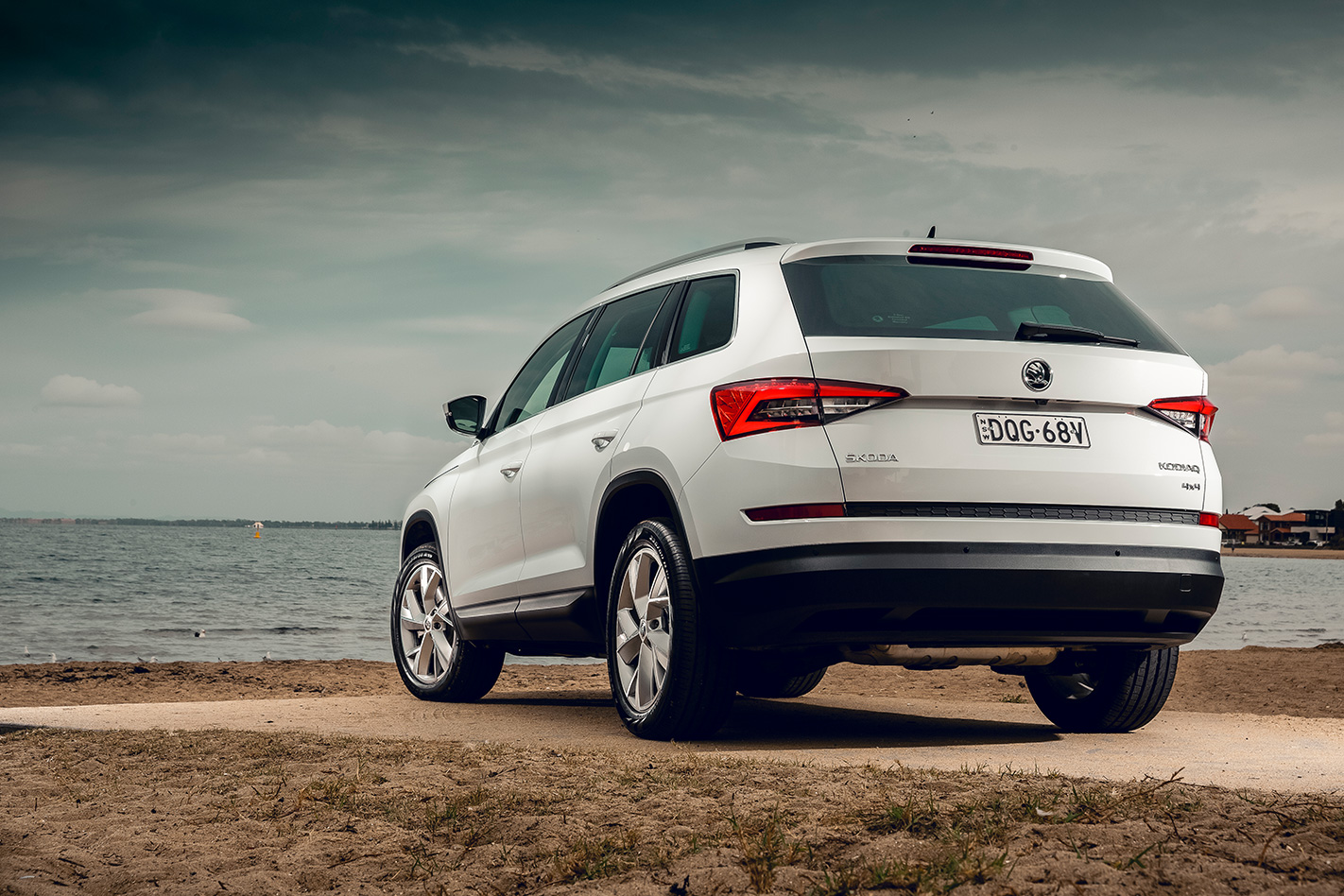
Students of automotive history might well recall the Matra Rancho, a French contrivance that pioneered this genre back in 1977. The front-drive Rancho was basically a Simca 1100 that went all-in on the 4×4 dress-up. There was even a Grand Raid model that featured nonsense like an electric winch and a spare wheel mounted on the roof. Despite being largely dreadful, the Rancho went on to spawn the Renault Espace, so as well as being an idea before its time, it helped create the MPV genre that today’s Peugeot 5008 so conspicuously shuns.
Whatever your take on its authenticity, there’s little doubt that the 5008 is a distinctive and deft piece of design. From the B-pillar forward, it’s virtually identical to the 3008, albeit with modified front bumper and grille designs. Peugeot has grafted another 165mm into the wheelbase to bump it to 2840, bringing the car’s length to 4641mm. While its wheelbase is 49mm longer than the Skoda’s, the 5008 is 56mm shorter than the Czech wagon and a massive 434mm less than the CX-9, and size counts in the seven-seat SUV sector.
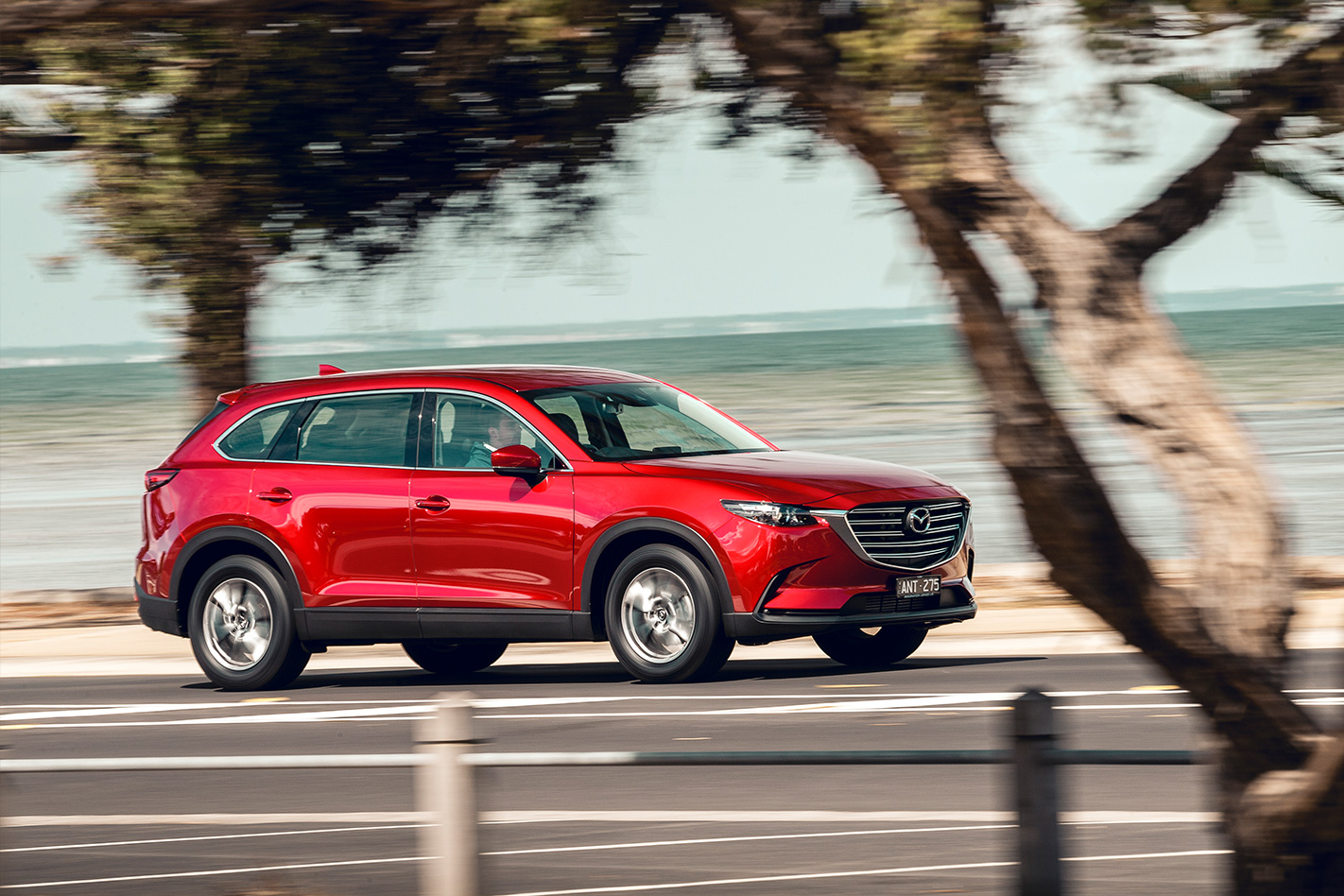
The Peugeot wings it at $46,990 in GT-Line guise, although options bump that price up to $53,740 as tested (see sidebar, p.101). The Kodiaq 132TSI is, refreshingly, supplied in almost bare-bones spec aside from metallic paint, the base price of $42,990 looking strong value, especially as it’s the only car of the trio with all-wheel drive (though shares a five-year warranty with the Peugeot). The Mazda is the most expensive car here in front-drive Touring trim, wearing a $50,290 sticker. It’s also the oldest of the three, so perhaps it’s going to face a tougher test than initially expected.
While it’s bigger and a massive 388kg heavier than the 1470kg Peugeot, the CX-9 counters with a real sledgehammer of an engine, for this class at least. The 170kW/420Nm 2.5-litre direct-injection turbo four makes the Pug’s 121kW/240Nm 1.6-litre unit look seriously malnourished, even when you take weight into consideration. The 132kW/320Nm engine in the Kodiaq sits somewhere in the middle and these outputs are reflected in respective performance figures, the Mazda being notably quicker than the others, hitting 100km/h in 7.4sec when bolstered to 188kW via 98-octane juice.

The Skoda was a little trickier to launch, the dual-clutch transmission not lending itself to being loaded up off the line, and registered 8.8sec 0-100km/h, while the 5008 was left struggling in their wake at 10 flat, half a second ahead of Peugeot’s conservative claim.
Sure, you don’t buy a seven-seat bus to crush it at stoplight grands prix, but it’s always good to have a bit in reserve. It’s some measure of the Mazda’s potency that it accelerates from 80-120km/h 32 percent quicker than the Peugeot. That could be the difference between a safe overtake and having to sit behind a truck until the next passing lane. That’s assuming the Peugeot hasn’t taken the long and winding road instead because in terms of driving reward, the slowest car here is definitely the most fun.

You’ll feel the Peugeot’s lightness in the alacrity of its responses, and although you may harbour the suspicion that the EMP2 architecture might actually be comprised of fairy floss and helium (it’s not), you’ll love the way it changes direction. The tiny steering wheel requires almost three turns lock-to-lock but it feels tightly geared about the straight ahead, with sharp turn-in and minimal pitch and roll.
Ride quality is respectable, however the torsion-beam rear end injects a bit of noise via the cargo compartment, and the engine needs continual encouragement to make respectable progress. But you’re helped by a Sport mode that weights up the steering, sharpens the throttle response and brings some welcome smarts to the otherwise languid six-speed automatic calibration.
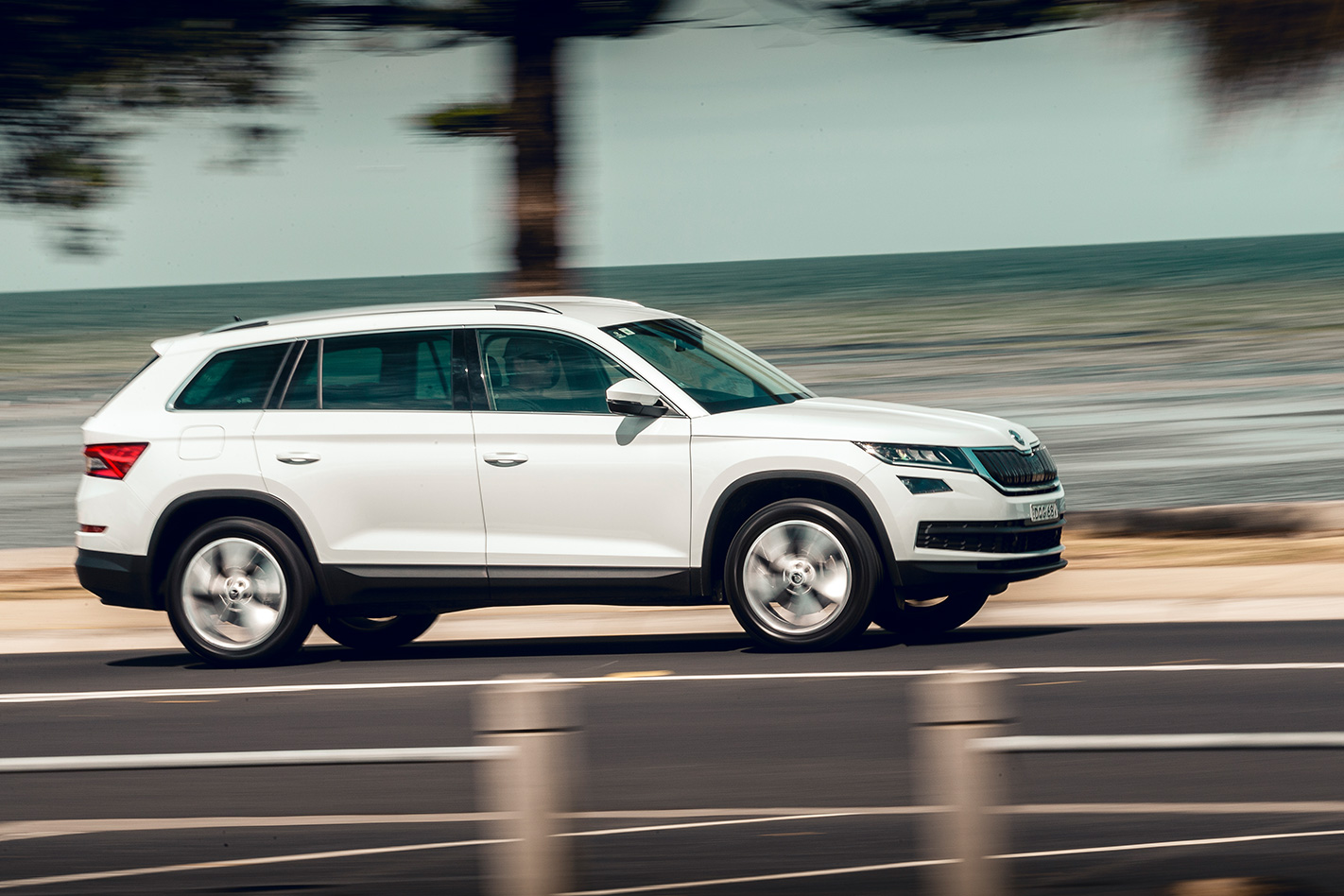
Drive the Kodiaq along the same road at the same speed and you expect it to be a bit of a handful, but it’s certainly game. It does feel like it’s clinging on a bit though, and the Skoda driver will be gritting their teeth while the 5008 pilot is grinning like an idiot. Back off a bit and the Skoda feels fun in its own way, delivering great front end bite for a big ’un, taciturn but accurate steering, admirable body control and comfortably the best brakes of the trio.
We’ve come to expect this level of excellence from Volkswagen Group products riding on the MQB chassis, and there are few genuine complaints about the way the Skoda drives. The DSG transmission’s hesitation to accelerate from standstill has us slightly perplexed, though, an issue also noted during this year’s Car of the Year testing. The suspension is also a bit more composed in compression than rebound but other than that, the Skoda earns a standout report card on both drivetrain and chassis.
The Mazda feels its size after you drive the others. Its bitumen credentials are compromised from the outset by Yokohama Geolandar H/T 60-series bouncy castles at each corner, but what you lose in corner carving ability, you gain back in ride quality. It’s possible to hustle it along a back road at a fair lick, and the CX-9 backs up the best engine with the smartest transmission calibration of the trio.
It rarely disguises its bulk, though the CX-9 telegraphs its limits in a sensible fashion. On poor surfaces, you feel the unsprung weight of the front wheel assemblies occasionally struggling to damp and isolate shock loadings, but otherwise refinement is exemplary. Because of the vast reserve of torque the 2.5-litre engine places at your disposal, you’ll rarely feel the requirement to go full Neanderthal on the throttle pedal, instead preferring to keep the transmission in its default setting where it does an admirable job of economically tipping into the engine’s torque plateau.
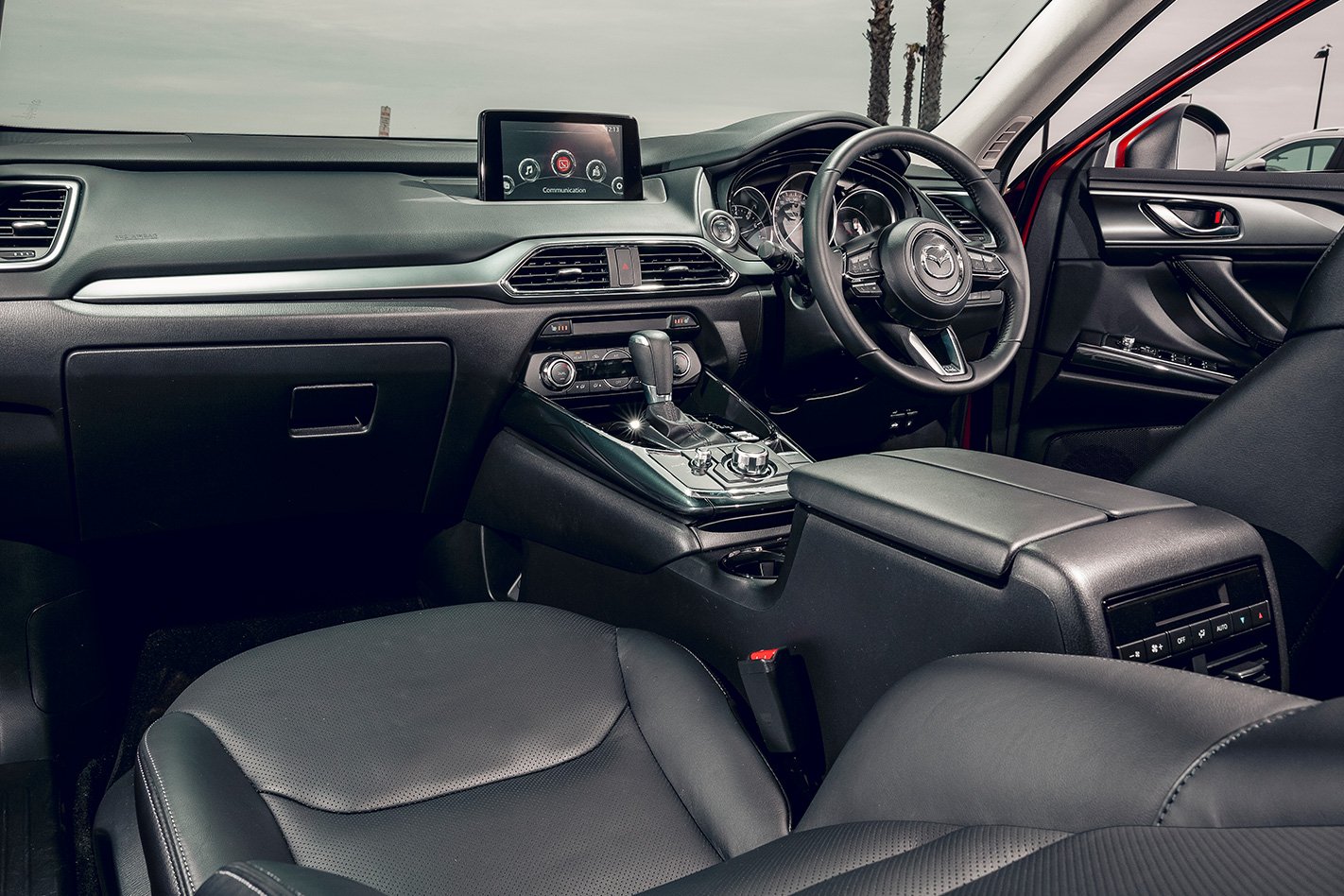
The massive cabin of the CX-9 is a great place to cover big kilometres in either the front or middle rows. It’s also the only car here where the rearmost pair of seats feature top tethers, which could swing a decision for those with a need to fit child seats or booster seats into the third row. The dash architecture still looks neat and logical, with the welcome fitment of physical dials for audio volume, air-con and drive modes. That said, the twin omissions of a digital speedo and adaptive cruise control date the CX-9 somewhat. The infotainment screen also appears a generation behind the Skoda’s slick system.
The second row in the Mazda is particularly good, allowing a decent recline for the flattish 60/40 split, a sliding bench, lots of legroom and acres of space to get your feet under the seats in front. The view ahead is good, with the rear occupants sitting higher, theatre style, though taller passengers will have to duck their heads to get in. Even with the second row reclined to the farthest extent, the third row can raise and drop. Fold both rows and you have a virtually flat load floor that almost induces agoraphobia.
If the CX-9’s cabin is all about well-judged practicality, the Peugeot responds with a high-concept assault on the senses. Our test car was fitted with beautiful quilted Nappa leather seats with a massage function, including ‘Cat Paw’ setting which does indeed feel like that thing that moggies do when they climb onto your doona at 3am and stomp up and down on your unmentionables, dribbling and purring like simpleton. Switch the cryptic Multi Sensory Ambience button between Relax and Boost, and the 5008 will alter lighting, drive mode, massage functions and even fragrance, switching the latter from Harmony Wood to Cosmic Cuir. That’s so French, you almost feel tempted to shrug, start every sentence with ‘beeeeurrrggh’ and set fire to a McDonalds.
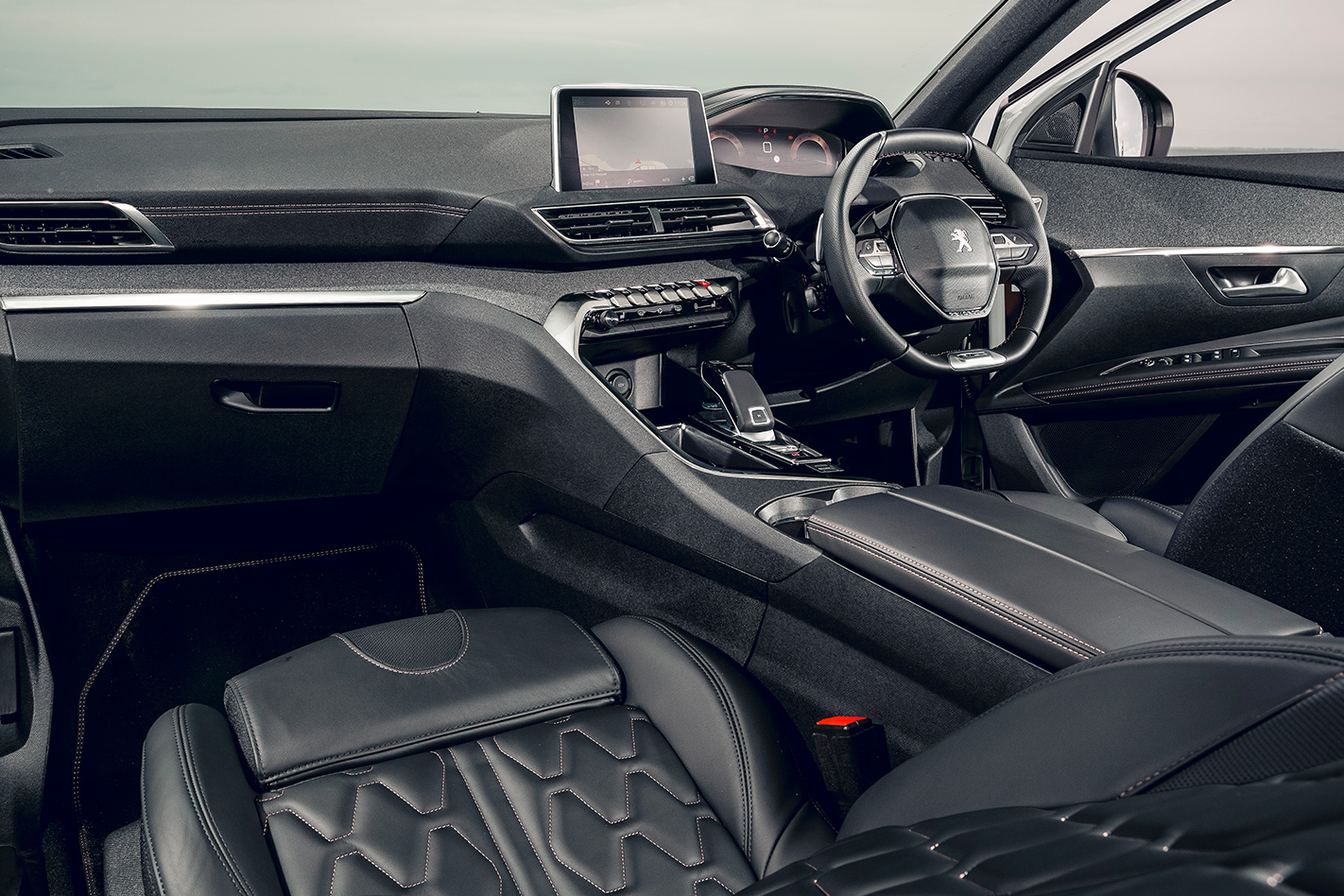
You get a sweep of fabric that runs across the doors and dash, and a liberal slathering of metal finishes that makes both of the others feel sourly utilitarian. If you’d rather your next vehicle purchase wasn’t some sort of suburban box-ticking exercise, the 5008 has appeal.
But its sheer lack of size counts against it as a seven seater. It’s comfortably the worst of this trio at that. Whereas the CX-9 gets cut-outs in the back of its front seats to boost space, the 5008 fits a set of faintly useless hard plastic tables that rob you of the kneeroom it has. Our test car was optioned with a vast panoramic glass roof that kills the car as a viable proposition for anybody much over 180cm, sacrificing 68mm of front headroom (and 20mm in the second row) from the fairly low-set roofline. Yet because it’s the only car here that houses its spare wheel in a basket under the car, there’s room for two soft bags beneath the third row when in use, and additional space if each (11kg) seat is removed.
The 33/33/33 split second row is a neat thing, with each position individually sliding, and the outer two reclining, and unlike the front-wheel-drive Mazda (which shares its sheetmetal with an all-wheel-drive version), the Peugeot’s commitment to front drive means that there’s no transmission tunnel for the middle passenger to contend with.
There’s also a 220V three-pin inverter in the second row, although it takes a little finding. The rearmost pair of seats take a bit of erecting from the flat load floor. First you need to contend with the origami mission of folding flaps and then there’s the rear parcel shelf bar which ends up directly in front of the popped-up seats.
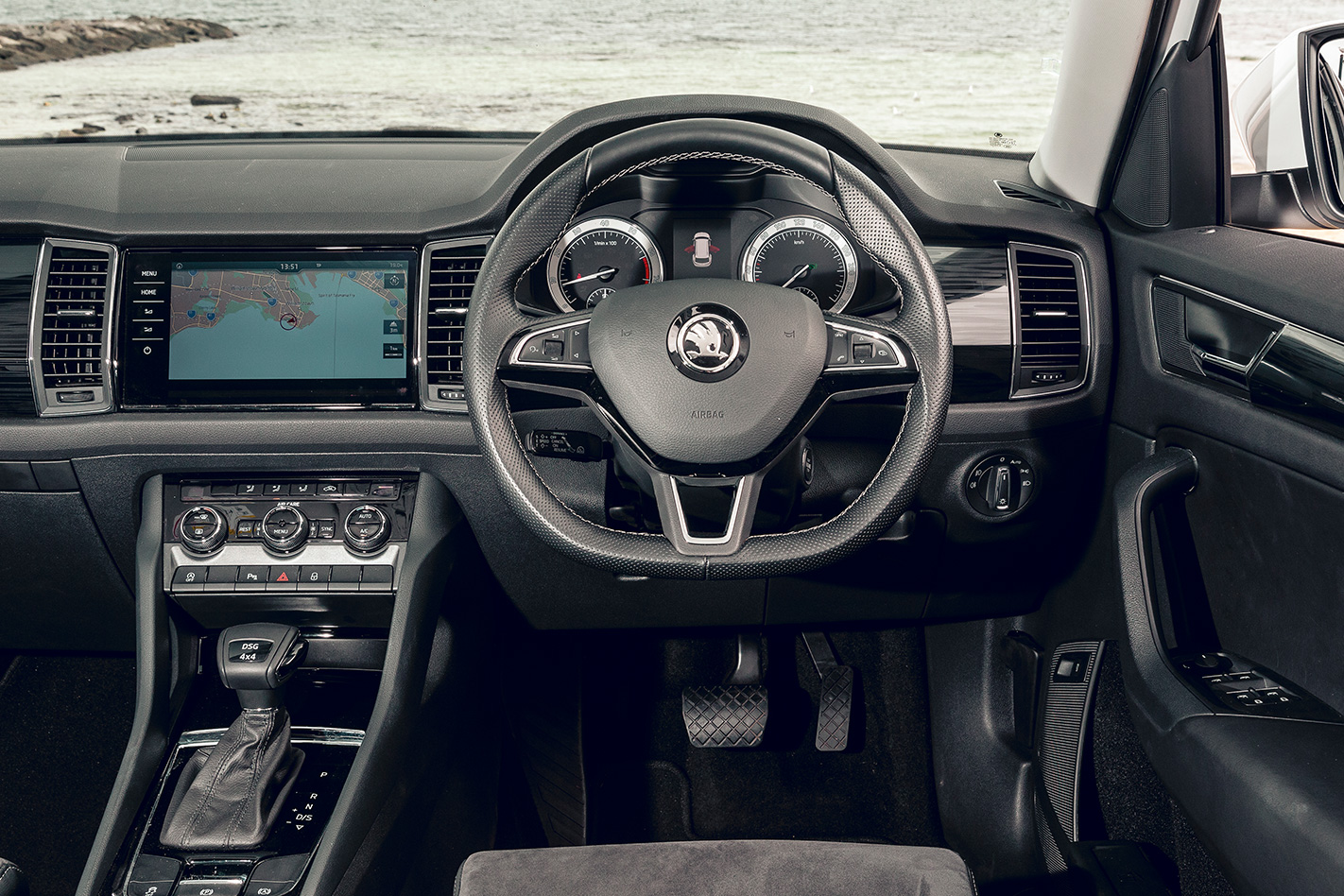
Contrast that with the Skoda, which features a clever rear-seat system and a parcel shelf that stashes beneath the boot floor, snuggled into place by a pair of neatly-packed travel blankets. It’s all encapsulated by Skoda’s ‘Simply Clever’ tagline and, along with the double-deck glovebox, umbrellas in the doors and flipover cubby tidies, actually has some substance. The second row splits 60/40 and both parts slide and recline, but the centre position is hard and the only seat in the house not trimmed in smart suede-cloth upholstery. There’s also less foot space in the Kodiaq, thanks to the front occupants’ underseat drawers.
The Peugeot has much to commend it and while it’s not a great seven-seater, it would be our prime pick for urban style-driven buyers who want something with a bit of space for equipment-heavy hobbies but don’t want the stigma that comes with owning a vanilla soft-roader. It drives well, it’s easily the most economical of this bunch and, above all, it’s fresh, interesting and endearing. Judged on purely pragmatic criteria, the 5008 finishes last here. But if you take into account what it manages to squeeze into its svelte form (it’s 54mm shorter than an Outlander, for example), the Pug’s compactness could be just what inner-city parents crave.
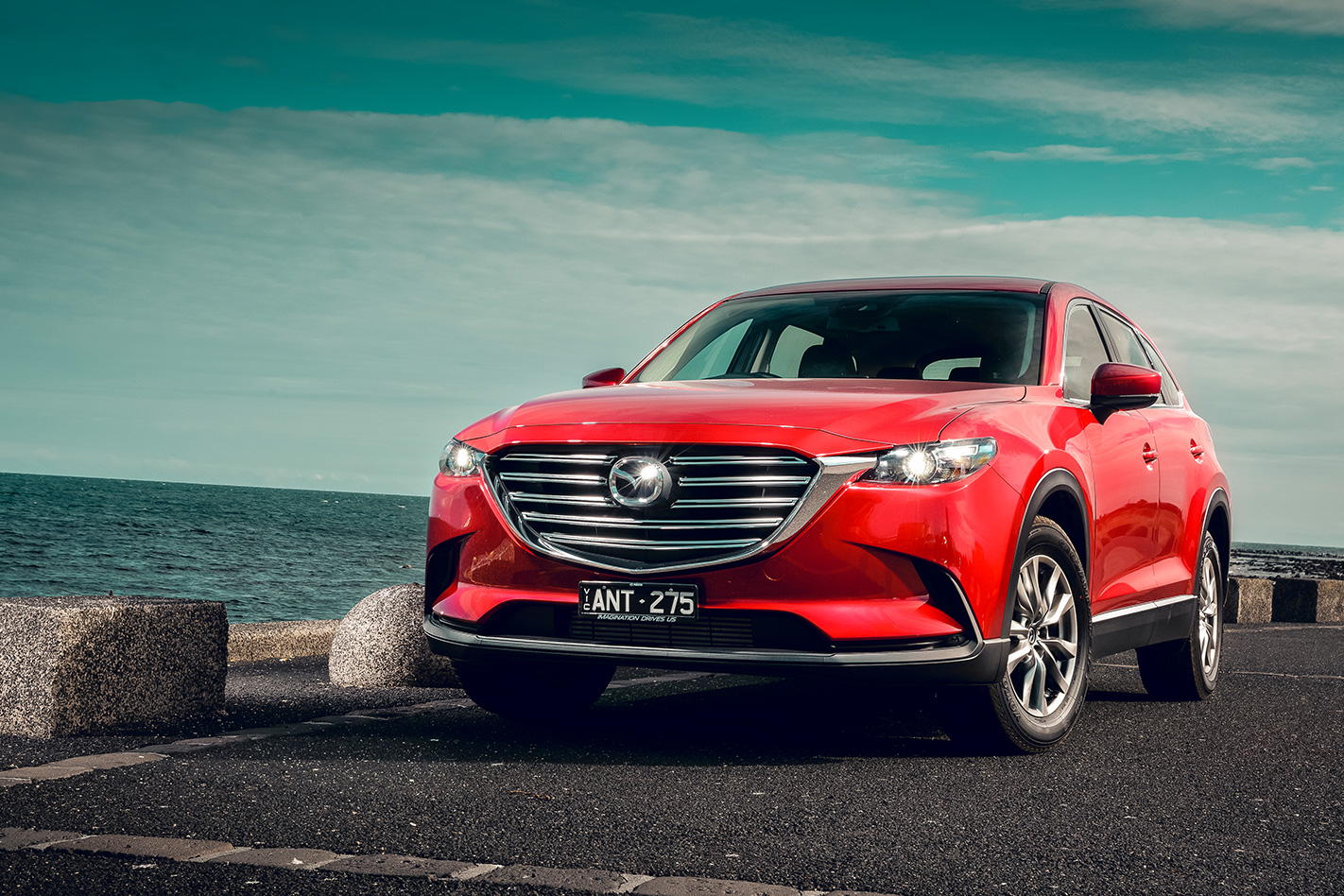
The Skoda has more to it than first meets the eye. All-wheel drive endows it with a level of authenticity, its drivetrain both classy and economical, its interior smart and its ownership credentials burnished by strong manufacturer support. It would be a painless purchase and one that we’d heartily recommend if surprise-and-delight utility stirs your loins.
It doesn’t quite have the chops to topple the Mazda, though. The CX-9 hugely impressed us in 2016 and it’s still the pick of the seven-seat bunch. Bigger, quicker and more comfortable is a formula that is always going to be tough to beat. Back that up with strong equipment, great ride quality and the most family-friendly focus of the three and it gets more of the things that matter right, more often.
The caveat, of course, is its considerable size, but if you can accommodate a CX-9, then it will happily do the same in return. We called this one early, but we called it right. After all, a good big ’un usually beats a good little ’un.


